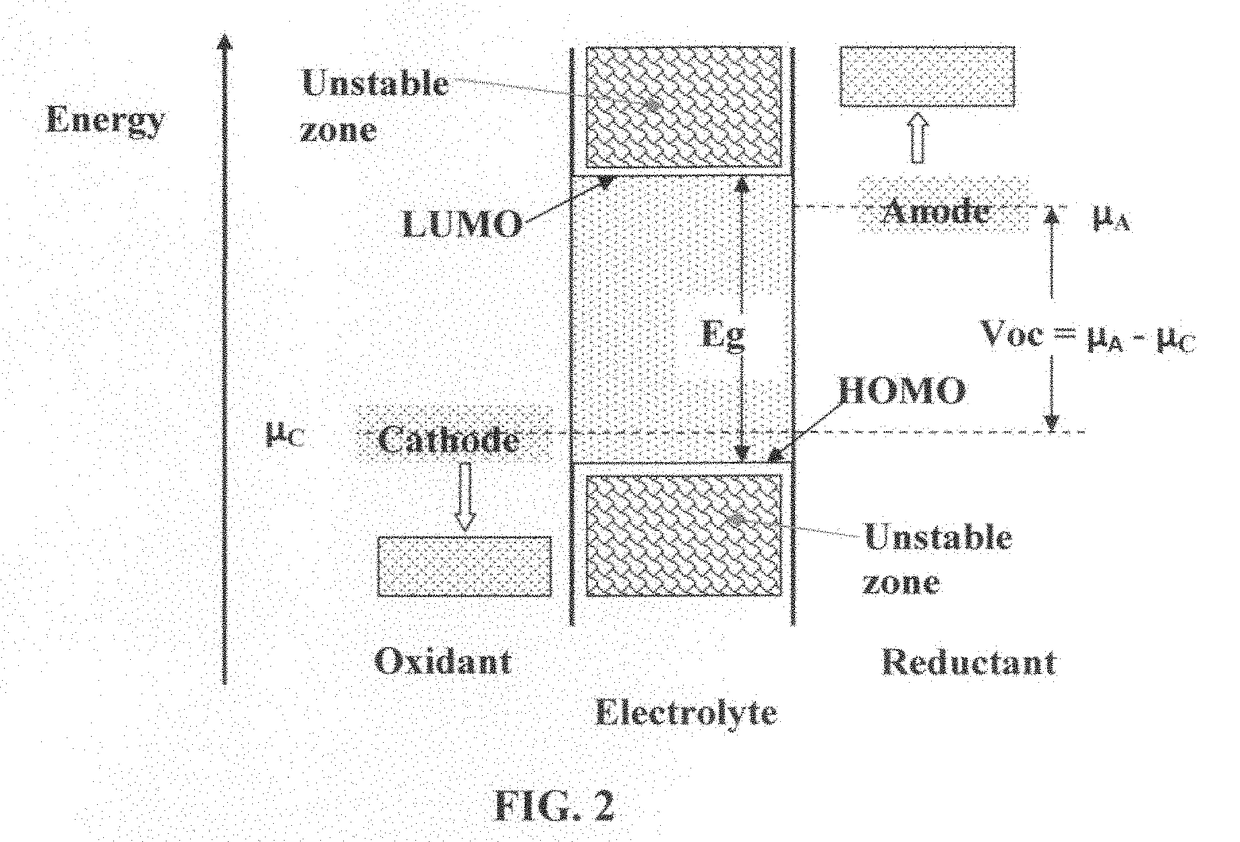Solid state electrolyte for lithium secondary battery
a lithium-ion battery and solid-state electrolyte technology, which is applied in the direction of batteries, sustainable manufacturing/processing, cell components, etc., to achieve the effect of preventing potential li metal dendrite-induced internal short circuit and thermal runaway problems, low electric and ionic conductivities, and simple, cost-effective and easy-to-implement approach
- Summary
- Abstract
- Description
- Claims
- Application Information
AI Technical Summary
Benefits of technology
Problems solved by technology
Method used
Image
Examples
example 1
of Sulfonated Polyaniline (S-PANi)
[0107]The chemical synthesis of the S-PANi polymers was accomplished by reacting polyaniline with concentrated sulfuric acid. The procedure was similar to that used by Epstein, et al. (U.S. Pat. No. 5,109,070, Apr. 28, 1992). The resulting S-PANi can be represented by the following Formula 1, with R1, R2, R3, and R4 group being H, SO3− or SO3H (R5=H) with the content of the latter two being varied between 30% and 75% (i.e., the degree of sulfonation varied between 30% and 75%).
[0108]The lithium ion conductivity of these SO3− or SO3H-based S-PANi compositions was in the range of 8.5×10−5 S / cm to 4.6×10−3 S / cm and their electron conductivity in the range of 0.1 S / cm to 0.5 S / cm when the degree of sulfonation was from approximately 30% to 75% (with y being approximately 0.4-0.6).
[0109]The solid state electrolyte was obtained by dissolving S-PANi in water or acetonitrile to form a polymer-water or polymer-solvent solution and dissolving commercially ava...
example 2
d Conducting Polymers (Sulfonated Polypyrrole, S-Ppy)
[0111]A sulfonated pyrrole-based polymer (with X=NH and Y=SO3−, m=1, and A=H in the following formula) was synthesized by following a procedure adapted from Aldissi, et al., U.S. Pat. No. 4,880,508, Nov. 14, 1989.
[0112]Approximately 5.78 g of the resulting sulfonated pyrrole-based polymer was dissolved in 100 ml of distilled water. Then, 105 ml of 0.98% aqueous LiOH and LiNO3 (50 / 50) were added to the sulfonated polypyrrole (S-PPy)-polyethylene oxide (PEO) water suspension over the course of 60 minutes while stirring constantly. The resulting polypyrrole-inorganic species composite was used as a solid state electrolyte.
example 3
on of Poly (Alkyl Thiophene) as an Electron-Conducting Component of a Mixture
[0113]Water-soluble conductive polymers having a thiophene ring (X=sulfur) and alkyl groups containing 4 carbon atoms (m=4) in the above Formula 2 were prepared, according to a method adapted from Aldissi, et al. (U.S. Pat. No. 4,880,508, Nov. 14, 1989). The surfactant molecules of these polymers were sulfonate groups with sodium. Conductivity of this polymer in a self-doped state were from about 10−3 to about 10−2 S / cm. When negative ions from a supporting electrolyte used during synthesis were allowed to remain in the polymer, conductivities up to about 50 S / cm were observed.
[0114]A doped poly (alkyl thiophene) (PAT) with Y=SO3H and A=H in Formula 6 that exhibited an electron conductivity of 12.5 S / cm was dissolved in water. A sulfonated poly(ether ether ketone)-based material called poly (phthalazinon ether sulfone ketone) (PPESK), having a degree of sulfonation of approximately 93%, was soluble in an aq...
PUM
| Property | Measurement | Unit |
|---|---|---|
| Fraction | aaaaa | aaaaa |
| Electrical conductivity | aaaaa | aaaaa |
| Electrical conductivity | aaaaa | aaaaa |
Abstract
Description
Claims
Application Information
 Login to View More
Login to View More - R&D
- Intellectual Property
- Life Sciences
- Materials
- Tech Scout
- Unparalleled Data Quality
- Higher Quality Content
- 60% Fewer Hallucinations
Browse by: Latest US Patents, China's latest patents, Technical Efficacy Thesaurus, Application Domain, Technology Topic, Popular Technical Reports.
© 2025 PatSnap. All rights reserved.Legal|Privacy policy|Modern Slavery Act Transparency Statement|Sitemap|About US| Contact US: help@patsnap.com



